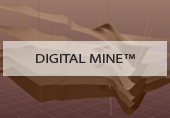The mine shafts are the lifeline to underground mines, and miners depend on safe uninterrupted and efficient flow of material. The shafts and hoisting systems provide access to network of openings used to recover the underground resource, carry out vertical transportation of miners and materials required for the mining operations, and serve as an escape way in case of emergency. In addition the shafts assist in mine ventilation and supply of engineering services underground (power, compressed air, water, cooling conduit etc.).

Schematic view of an underground mine
Most underground mines have 3 shafts (rock shaft, service shaft and the ventilation one) and if something ever happens to any shaft the production can be severely disrupted and consequently the mine may suffer serious financial losses.
Mining shaft generally is a very complex engineering object but from a geometrical and topological point of view it can be described it as a cylinder with a diameter of 5-20 metres and the depth of 100-3000 metres in a single go. Inside a single shaft there are many different objects: pipes of various diameters, cables, vertical guides (rails for the conveyances), horizontal steel beams (buntons), fixing brackets and other attachments. Shaft lining is normally constructed from reinforced concrete or cast-iron tubbing rings. Besides that each shaft has one or few stations – intersections with mining levels (horizontal mining workings).

Inside of a ventilation shaft (photo: Murray & Roberts)
In any point of time all of the shaft constructive elements must be kept in good working conditions for the uninterrupted and safe mining operations. For instance, all guides must be perfectly aligned as the vertical speed of conveyances e.g. 50-t skip can reach 12-18 m/sec.
The description of the existing problem.
Every mine shaft must be stopped for 4-12 hours (depending on the shaft depth) per week in order to undergo its visual inspection. This legal requirement is stipulated by law in every major mining country e.g. Canada, USA, South Africa, Australia, Germany, Russia, Ukraine etc.
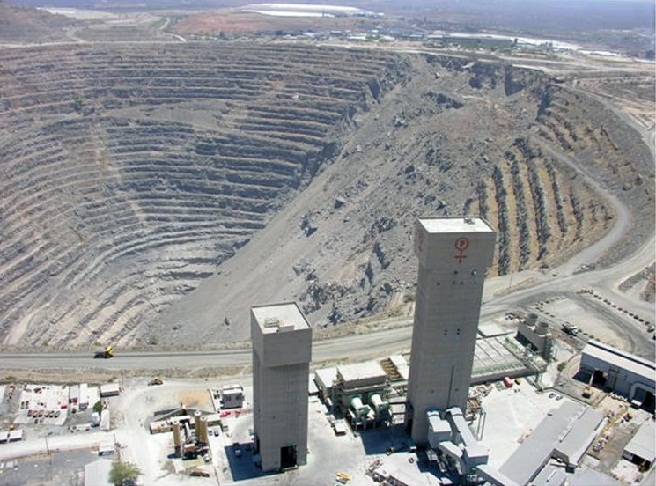
Mine shaft headframes, Palabora copper mine, South Africa (photo: Palabora Mining Company)
The current practice of mine shaft inspection have several disadvantages. The most important one are as follows:
- significant revenue losses due to production interruption;
- safety issues: people exposure to the dangerous working conditions resulting in severe injuries and even fatalities every year – huge indirect losses;
- visual inspection conducted by human eye is not perfect – serious mine shaft accidents still happen including the ones caused by human error, which results in additional production and consequently financial losses and often in fatalities.
The need for better and more efficient technology is confirmed by mining professionals – mining executives and shaft engineers as well as the governmental officials in the most of the major mining countries.
What is the Laser Scanning?
LiDAR (Light Detection and Ranging) is the integrated system consisting of three components: lasers, GPS (Global Positioning System) and IMU (inertial Measurement Unit), the latter in essence is an optical gyroscope. The integration of all these system’s components allows determining with extremely high accuracy the co-ordinates of the point in space where a laser beam reflects from a non-transparent object. LiDAR systems are widely used to effectively collect spatial data for DEM building. In addition the laser beam can penetrate through foliage therefore this technology is applicable even in the heavily forested areas. The application of LiDAR technology varies from construction industry and road maintenance to city management and planning. The LiDAR systems are used in either airborne or terrestrial based mode.
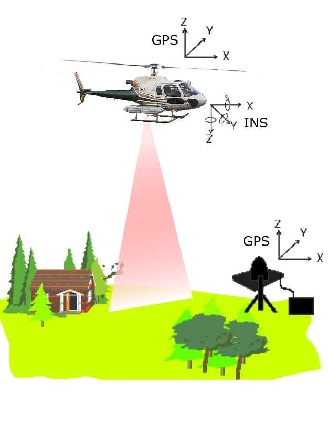
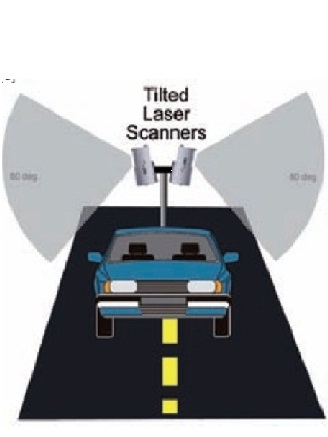
Schematic view of the airborne and terrestrial-based LiDAR systems
The proposed technology
The idea is to create the initial 3D “basic” scans (for new shafts – after shaft commissioning when all permanent steelwork and equipment are installed inside a shaft barrel) for the current shaft conditions. Subsequently the shaft scanning system can be used as frequently as required by a Shaft Engineer, for instance, on weekly basis. By comparing the subsequent scans it is possible to determine all changes and their severity, specify which element of shaft infrastructure was affected, generate reports etc.
The advantages of the developed technology
What kind of benefits the proposed technology can offer to underground mines with the scanning of their mine shafts infrastructure?
- the automated shaft monitoring system will offer the better accuracy than human eye can measure. The role of human factor in particular fatigue, lost of concentration, bad lighting will diminish;
- earlier detection of defects in shaft infrastructure will reduce the probability of accidents thus increasing the safety and efficiency of mining operations;
- the amount of man-hours spent by engineering and technical staff in the dangerous conditions inside the shaft barrel will decrease therefore reducing the probability of lost time injures for mine personnel;
- the shaft scanning is quick and unobtrusive for mining operations with the LiDAR system (attached to any conveyance) moving up and down the shaft with a normal hoisting speed. Hence the shaft availability increases and subsequently the mine can realize a significant financial gain from the increased production;
- a 3D realistic picture of the entire shaft with all internal infrastructures (constructive elements) is created which allows conducting the detailed visual analysis in the comfortable office conditions. Shaft Engineer will be capable of interactively building any horizontal and vertical cross-sections, together with the ability to measure the sizes, distances, diameters as well as the angles from vertical and horizontal axles and compare them to the originally designed shapes etc;
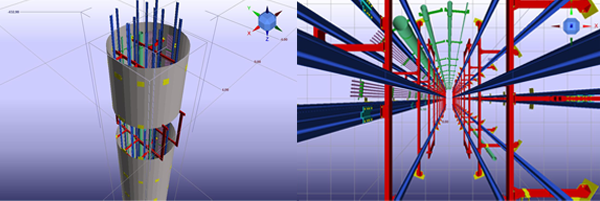
Laser scanning result – 3D picture of a mine shaft and its internal infrastructure
- superimposition of the subsequent 3D scanned images can immediately determine and highlight the areas of concerns (ground movements, cracks in lining, misalignment and deflections of pipes, buntons and guides etc.) as each element of such image can be compared on-the-fly with its own past position, original shape etc;
- with the assistance of the unique recognition protocol each and every object inside the shaft can be specified. The defect report contains a reference to the affected element and it’s location in the shaft. The allowable margin of changes as well as the severity of damage can be determined for each constructive element. That can be further divided into following categories: change of shape, change of location, level of corrosion and rust build-up. The implemented feature extraction algorithms enable the comparison of any shaft object with its original predetermined shape, location, level of corrosion or rust built-up thus allowing a shaft engineer to plan his maintenance work more smartly;
- the ability to archive all scanned images and to support a history log of all changes further assists in determining the chronic and newly revealed problems with mine shaft thus improving the whole shaft management system and making its maintenance more efficient.
The proposed technology is highly scalable as currently there are more than 1000 operational mine shafts around the world.
An additional fields of application for the developed technology are subways (~100 in all major cities around the world) and high-volume transportation tunnels e.g. Eurotunnel between UK and France, St. Gotthard tunnel between Switzerland and Italy and so on.







